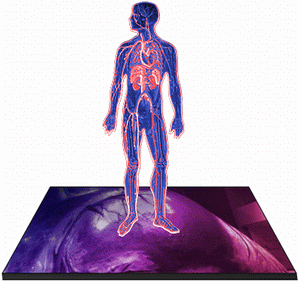
![]()
Home
![]()
Editorial
![]()
Free
Medical Advice
![]()
Patient Education
![]()
Review
![]()
Interview
![]()
Horizons
![]()
Sections
![]()
News
![]()
Events
![]()
Directory
![]()
Jokes
![]()
Links
The Heart

About Dr Abdul Hafeez Chaudhry
Tubular Circulation
In a general sense, a vessel is defined as a hollow utensil for carrying something:
a cup, a bucket, a tube. Blood vessels, then, are hollow utensils for carrying blood.
Located throughout your body, your blood vessels are hollow tubes that circulate your
blood.
There are three varieties of blood vessels: arteries, veins, and capillaries. During blood
circulation, the arteries carry blood away from the heart. The capillaries connect the
arteries to veins. Finally, the veins carry the blood back to the heart.
If you took all of the blood vessels out of an average child, and laid them out in one
line, the line would be over 60,000 miles long! An adult's vessels would be closer to
100,000 miles long!
Besides circulating blood, the blood vessels provide two important means of measuring
vital health statistics: pulse and blood pressure. We measure heart rate, or pulse, by
touching an artery. The rhythmic contraction of the artery keeps pace with the beat of the
heart. Since an artery is near the surface of the skin, while the heart is deeply
protected, we can easily touch the artery and get an accurate measure of the heart's
pulse.
When we measure blood pressure, we use the blood flowing through the arteries because it
has a higher pressure than the blood in the veins. Your blood pressure is measured using
two numbers. The first number, which is higher, is taken when the heart beats during the
systole phase. The second number is taken when the heart relaxes during the diastole
phase. Those two numbers stand for millimeters. A column of mercury rises and falls with
the beat of the heart. The height of the column is measured in millimeters. Normal blood
pressure ranges from 110 to 150 millimeters (as the heart beats) over 60 to 80 millimeters
(as the heart relaxes). It is normal for your blood pressure to increase when you are
exercising and to decrease when you are sleeping. If your blood pressure stays too high or
too low, however, you may be at risk of heart disease.
It's All in the Lungs
Pulmonary circulation is the movement of blood from the heart, to the lungs, and back to
the heart again. This is just one phase of the overall circulatory system.
The veins bring waste-rich blood back to the heart, entering the right atrium throughout
two large veins called vena cavae. The right atrium fills with the waste-rich blood and
then contracts, pushing the blood through a one-way valve into the right ventricle.
The right ventricle fills and then contracts, pushing the blood into the pulmonary artery
which leads to the lungs. In the lung capillaries, the exchange of carbon dioxide and
oxygen takes place. The fresh, oxygen-rich blood enters the pulmonary veins and then
returns to the heart, re-entering through the left atrium. The oxygen-rich blood then
passes through a one-way valve into the left ventricle where it will exit the heart
through the main artery, called the aorta. The left ventricle's contraction forces the
blood into the aorta and the blood begins its journey throughout the body.
The one-way valves are important for preventing any backward flow of blood. The
circulatory system is a network of one-way streets. If blood started flowing the wrong
way, the blood gases (oxygen and carbon dioxide) might mix, causing a serious threat to
your body.
You can use a stethoscope to hear pulmonary circulation. The two sounds you hear,
"lub" and "dub," are the ventricles contracting and the valves
closing.
